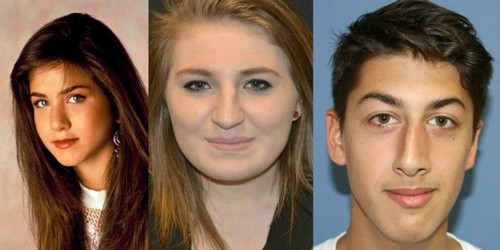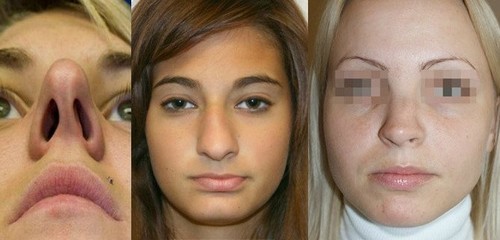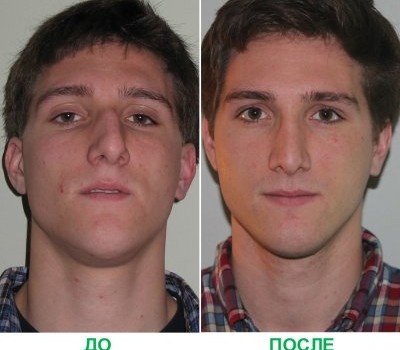Experienced craniofacial surgeons say that perfect anatomy of the nose nature is not to be found. Insidious violation of the process of formation in early childhood is not noticeable to the naked eye.
But in most cases, a crooked nasal septum remains within the normal range and does not obstruct the physiological process of breathing, and sometimes changes become pathological. There are various reasons for the formation of such anomalies.
A deviated septum in children and adults may be exacerbated by various injuries, after the transferred inflammatory diseases. This requires treatment by an otolaryngologist and possibly even surgical repair. Usually the effects of the curve of the nasal septum can be very sad, about what difficulties may arise – can be read in this material.
Anatomy, physiology and deviation from the norm
If you look at health statistics, we can see that the majority of diagnosed cases occur in adolescence (11-15 years). Up to 10 years to detect the anomaly-forming structures of the nose very difficult. Anatomy and physiology of the upper respiratory tract is such that compensation mechanisms allow to tolerate even significant deviation from the norm.
However, it is in adolescence on the background of intense and rapid development of the facial skeleton and hormonal changes such deviations can evolve even without the influence of external negative factors.

Anatomy of the nose divides the body into structural parts:
- the input path of the nostrils and the cavity (here permeates the air, is the primary treatment and heating);
- nasal passages originate from the lower cavity, and then continue middle and upper section (the narrow way allows you to effectively warm and clean incoming air);
- hoani prevent the exit of air in the nasopharynx.
The nasal septum separates the two nasal stroke. It consists of bone in the posterior part of the cartilage and all the rest. The internal cavity is lined with mucous membrane, penetrated by small blood vessels. There is the ability of formation of mucous secretion with the aim of eliminating pathogenic microorganisms and dust particles. Area of olfaction (odor recognition) is located in the upper nasal cavity. Therefore, even under light congestion, the ability to smell is sharply reduced. The functioning of this body help the sinuses.
Physiological function:
- moisturizing and cleansing of the air entering the upper respiratory tract;
- protection from pathogenic bacteria and viruses;
- the provision of smell and recognition of odors.
The role of the nasal septum is difficult to overestimate. She plays the role of a natural barrier to the connection of the two air streams. This creates the conditions for smooth physiological breathing. A deviated septum disrupts the process of breathing through the nose and creates the preconditions for the development of chronic diseases of the upper respiratory tract.
Causes of deviated nasal septum – identify risk factors
When developing measures for the prevention of various pathologies commonly identifies risk factors and develop a set of measures aimed at their neutralization. Causes of deviated nasal septum can include a huge number of factors internal and external pathogenic influence.
Try to deal with the main ones:
- physiological group is associated with violation of process of formation and development of facial bone of the skull;
- traumatic group is the impact of the shock, fractures, the development of cavities after hematomas;
- compensatory causes of deviated nasal septum include nasal polyps, sinusitis, adenoiditis, hypertrophy of the sinuses, chronic rhinitis.
Congenital risk factors are now being actively studied by scientists. There is a theory of insufficient density of cartilage. Such people suffer from systemic lesions hialuronowy structures. They may be present arthritis and arthrosis, osteochondrosis of spinal column, Bechterew’s disease. If the parents or older blood relatives out of the difficulties with joints and spine, then the probability curve of the nasal septum in children is very high. But the scientific substantiation of this theory yet.
What can be the consequences of a deviated nasal septum
Most patients think that if the external manifestations of the pathological state that you do not respond to periodic signals from the body. What can be the consequences of a deviated nasal septum in children and adults? A variety, sometimes it is even difficult to compare with major illness, so they are distant and not directly connected.
The main problem is the violation of the process air through the nasal passages. Simply put – it becomes difficult to freely breathe through the nose. This is the result of narrowing of one of the passages and a violation of the physiological dynamics of air movement.
The second possible negative consequence is a change in the structure of the mucous membrane. It becomes thickened and loses its protective properties. This leads to persistent viral infections, chronic rhinitis, frequently complicated by sinusitis, frontal sinusitis, sphenoiditis.
In the long term can develop chronic oxygen starvation of tissues. The chronic abnormalities of pulmonary and cardiac tissue, the development of migraines, low back pain and constant muscle cramps – all symptoms of such pathology.
From the Central nervous system can also be irreversible changes. The risk of developing asthma neurogenic origin such category of people is very high. Patients literally haunting recurring attacks of breathlessness, which by conventional means is not so simple. In marked violation of nasal breathing may develop epileptic seizures, convulsions, migraine headaches. Over time reduced visual acuity and hearing. In the cavity of the Eustachian tube are formed the conditions for the development of esthetica and otitis media.
Diagnosis and symptoms of deviated nasal septum (with photo)
There are several varieties of curvature of the nasal septum, they form their own clinical picture. Diagnosis of all of them begins with a visual examination and radiographic examination.
Very often there are combined options, there may be several types of curvature:
- the spike or comb;
- in vertical or horizontal position;
- back or front orientation;
- strain profile S or C;
- with the deformation of the bone tissue of vomer.
Look at a photo of a typical manifestation of the curvature of the nasal septum of various types:

Typical symptoms of a deviated nasal septum of the nose, which draws the attention of a specialist during the initial examination:
- complaints of difficulty breathing through the nose;
- constant feeling of congestion and the allocation of the mucous secret (exacerbated after cold air);
- allergic reactions are not typical for this person, for example, the smell of citrus fruits;
- periodic bleeding from the nasal passages – they are caused by mechanical trauma and violation of circulation of blood in the capillaries;
- sensation of dryness in the nose, snoring during sleep, frequent pains in throat;
- decreased performance and increased fatigue, headache and dizziness.
Visually can determine the change of the anatomical shape of the nose. During rhinoscopy, the doctor sees the uneven development of moves and sinks. Initial assessment of uniformity of air distribution can be carried out with a simple test with the fleece. One nostril tray with a dry cotton swab for the second nostril closed, watching the movement of the fleece when breathing. Then compare the range of motion in both nostrils. Similarly, it is possible to check the function of smell with the help of cotton wool soaked with the aromatic substance.
If you suspect a deviated septum, with the aim of differential diagnosis is radiography of the skull bones, computed tomography, endoscopy.
Methods of treatment of a deviated nasal septum and surgery
The most effective method of correction of the patient’s condition is surgery. Methods of treatment of a deviated nasal septum without surgery usually give only a temporary unstable result. To improve nasal breathing, it is recommended to use a vasoconstrictor drops, which in turn adversely affect the condition of the mucous membranes.

Surgery called septoplasty of the nose. It is the restoration of normal anatomical structures of the nasal septum. Granted to persons with shortness of breath, headaches, predisposition to bronchial asthma and serious cosmetic defects.
If the scheduled operation to correct a deviated nasal septum, it should be prepared in advance. It is important to give up Smoking and consuming hot, spicy foods. Should visit the dentist and treat all patients the teeth. This will ensure the prevention of postoperative complications of inflammatory nature.
The operation is performed in the hospital under General anesthesia. After the intervention of nasal breathing is fully restored during the first weeks. Work capacity is restored after 21 days.



